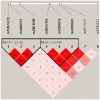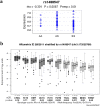Evidence for Association of Cell Adhesion Molecules Pathway and NLGN1 Polymorphisms with Schizophrenia in Chinese Han Population
- PMID: 26674772
- PMCID: PMC4682938
- DOI: 10.1371/journal.pone.0144719
Evidence for Association of Cell Adhesion Molecules Pathway and NLGN1 Polymorphisms with Schizophrenia in Chinese Han Population
Abstract
Multiple risk variants of schizophrenia have been identified by Genome-wide association studies (GWAS). As a complement for GWAS, previous pathway-based analysis has indicated that cell adhesion molecules (CAMs) pathway might be involved in the pathogenesis of schizophrenia. However, less replication studies have been reported. Our objective was to investigate the association between CAMs pathway and schizophrenia in the Chinese Han population. We first performed a pathway analysis utilizing our previous GWAS data. The CAMs pathway (hsa04514) was significantly associated with schizophrenia using hybrid gene set-based test (P = 1.03×10-10) and hypergeometric test (P = 5.04×10-6). Moreover, 12 genes (HLA-A, HLA-C, HLA-DOB, HLA-DPB1, HLA-DQA2, HLA-DRB1, MPZ, CD276, NLGN1, NRCAM, CLDN1 and ICAM3) were modestly significantly associated with schizophrenia (P<0.01). Then, we selected one promising gene neuroligin 1 (NLGN1) to further investigate the association between eight significant SNPs and schizophrenia in an independent sample (1814 schizophrenia cases and 1487 healthy controls). Our study showed that seven SNPs of NLGN1 and two haplotype blocks were significantly associated with schizophrenia. This association was confirmed by the results of combined analysis. Among them, SNP rs9835385 had the most significant association with schizophrenia (P = 2.83×10-7). Furthermore, in silico analysis we demonstrated that NLGN1 is preferentially expressed in human brain and SNP rs1488547 was related to the expression level. We validated the association of CAMs pathway with schizophrenia in pathway-level and identified one susceptibility gene NLGN1. Further investigation of the roles of CAMs pathway in the pathogenesis of schizophrenia is warranted.
Conflict of interest statement
Figures




Similar articles
-
Association of SOX11 Polymorphisms in distal 3'UTR with Susceptibility for Schizophrenia.J Clin Lab Anal. 2020 Aug;34(8):e23306. doi: 10.1002/jcla.23306. Epub 2020 Mar 23. J Clin Lab Anal. 2020. PMID: 32207210 Free PMC article.
-
A case-control association study of NRXN1 polymorphisms with schizophrenia in Chinese Han population.Behav Brain Funct. 2011 Apr 11;7:7. doi: 10.1186/1744-9081-7-7. Behav Brain Funct. 2011. PMID: 21477380 Free PMC article.
-
[Association of RELN SNP rs7341475 with schizophrenia in the Chinese population].Dongwuxue Yanjiu. 2011 Oct;32(5):499-503. doi: 10.3724/SP.J.1141.2011.05499. Dongwuxue Yanjiu. 2011. PMID: 22006801 Chinese.
-
A meta-analysis of FZD3 gene polymorphisms and their association with schizophrenia.Psychiatr Genet. 2016 Dec;26(6):272-280. doi: 10.1097/YPG.0000000000000155. Psychiatr Genet. 2016. PMID: 27755292
-
Human cell adhesion molecules: annotated functional subtypes and overrepresentation of addiction-associated genes.Ann N Y Acad Sci. 2015 Sep;1349(1):83-95. doi: 10.1111/nyas.12776. Epub 2015 May 18. Ann N Y Acad Sci. 2015. PMID: 25988664 Free PMC article. Review.
Cited by
-
Neuroligin 2 R215H Mutant Mice Manifest Anxiety, Increased Prepulse Inhibition, and Impaired Spatial Learning and Memory.Front Psychiatry. 2017 Nov 27;8:257. doi: 10.3389/fpsyt.2017.00257. eCollection 2017. Front Psychiatry. 2017. PMID: 29230184 Free PMC article.
-
Association of Candidate Single Nucleotide Polymorphisms Related to Candidate Genes in Patients With Schizophrenia.Basic Clin Neurosci. 2020 Sep-Oct;11(5):595-608. doi: 10.32598/bcn.9.10.470. Epub 2020 Sep 1. Basic Clin Neurosci. 2020. PMID: 33643553 Free PMC article.
-
Soluble Ectodomain of Neuroligin 1 Decreases Synaptic Activity by Activating Metabotropic Glutamate Receptor 2.Front Mol Neurosci. 2017 May 3;10:116. doi: 10.3389/fnmol.2017.00116. eCollection 2017. Front Mol Neurosci. 2017. PMID: 28515678 Free PMC article.
-
Polymorphisms of Ionotropic Glutamate Receptor-Related Genes and the Risk of Autism Spectrum Disorder in a Chinese Population.Psychiatry Investig. 2019 May;16(5):379-385. doi: 10.30773/pi.2019.02.26.3. Epub 2019 May 23. Psychiatry Investig. 2019. PMID: 31132842 Free PMC article.
-
Genomic regions and candidate genes associated with forehead whorl positioning in Thoroughbred horses.J Equine Sci. 2025;36(1):11-18. doi: 10.1294/jes.36.11. Epub 2025 Mar 10. J Equine Sci. 2025. PMID: 40115733 Free PMC article.
References
-
- Andreasen NC. Symptoms, signs, and diagnosis of schizophrenia. Lancet. 1995;346(8973):477–81. . - PubMed
Publication types
MeSH terms
Substances
LinkOut - more resources
Full Text Sources
Other Literature Sources
Medical
Research Materials

